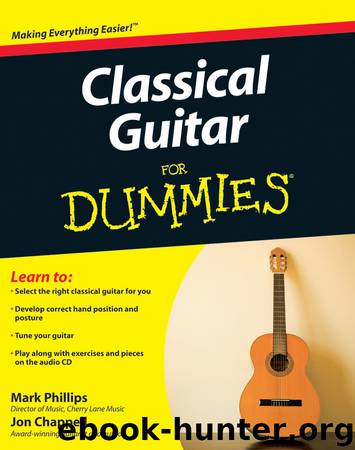Classical Guitar For Dummies by Jon Chappell

Author:Jon Chappell
Language: eng
Format: epub
Publisher: Wiley
Published: 2011-09-30T04:00:00+00:00
Chapter 8
Flat-Fingered Fretting with Barres
In This Chapter
Playing and practicing half and full barres
Using barres in full-length pieces
Classical guitarists move beyond beginner status when they learn and apply a number of skills and techniques that allow them to play virtually any classical guitar composition or arrangement. Among these skills, which we examine in this chapter and the four chapters that follow, are slurring notes, varying tone quality, playing in the higher positions, and highlighting melody lines from within arpeggios. But perhaps the most basic and essential skill a guitarist (classical or otherwise) needs is the ability to press down more than one string at a time with a single finger; or, to use the technical term for such a technique, the ability to barre.
Discovering How to Play Barres
When a single finger frets (presses down) more than one string at a time (across the neck at the same fret, that is), that finger is called a barre (from the French word barré, which means “bar”). And that term is appropriate, because when you use a single finger in such a manner, it resembles, well, a bar. And as a verb, to barre is to place or use a finger in such a fashion.
Often, the first finger forms a barre, sometimes stretching across all six strings, sometimes encompassing fewer. But you can use other fingers to form barres as well.
Barres (and chords that employ barres) are a bit tricky for beginners to master because notes under them ring out only if you apply sufficient pressure. But after you perfect the technique, barring actually makes playing easier in many situations, such as when fretting each string of a chord with a separate finger is awkward or impossible.
Barres come in two varieties: the full barre, which encompasses all six strings, and the half barre (also referred to as a partial barre), which covers anywhere from two to five strings. We know that two-sixths, four-sixths, and five-sixths don’t equal a half, but the term half barre is generally used to express all these fractional (partial) barres. In the following sections we look at both types of barres.
Half barre
Take a look at Figure 8-1, in which a first-finger barre covers the top three strings at the 2nd fret. Go ahead and duplicate that half barre on your own guitar. When you have the barre pressed down firmly, pluck the top three strings with your right-hand fingers p-i-m (first all at once, as a chord, then one at a time, as an arpeggio). All three notes should ring clearly.
Figure 8-1: Playing a half barre.
Download
This site does not store any files on its server. We only index and link to content provided by other sites. Please contact the content providers to delete copyright contents if any and email us, we'll remove relevant links or contents immediately.
The Goal (Off-Campus #4) by Elle Kennedy(13394)
Kathy Andrews Collection by Kathy Andrews(11695)
Diary of a Player by Brad Paisley(7427)
What Does This Button Do? by Bruce Dickinson(6111)
Assassin’s Fate by Robin Hobb(6072)
Big Little Lies by Liane Moriarty(5667)
Altered Sensations by David Pantalony(5019)
Pale Blue Dot by Carl Sagan(4873)
Sticky Fingers by Joe Hagan(4074)
The Death of the Heart by Elizabeth Bowen(3499)
The Heroin Diaries by Nikki Sixx(3466)
Beneath These Shadows by Meghan March(3239)
Confessions of a Video Vixen by Karrine Steffans(3216)
How Music Works by David Byrne(3098)
The Help by Kathryn Stockett(3056)
Jam by Jam (epub)(2997)
Harry Potter 4 - Harry Potter and The Goblet of Fire by J.K.Rowling(2955)
Strange Fascination: David Bowie: The Definitive Story by David Buckley(2773)
Petty: The Biography by Warren Zanes(2654)
